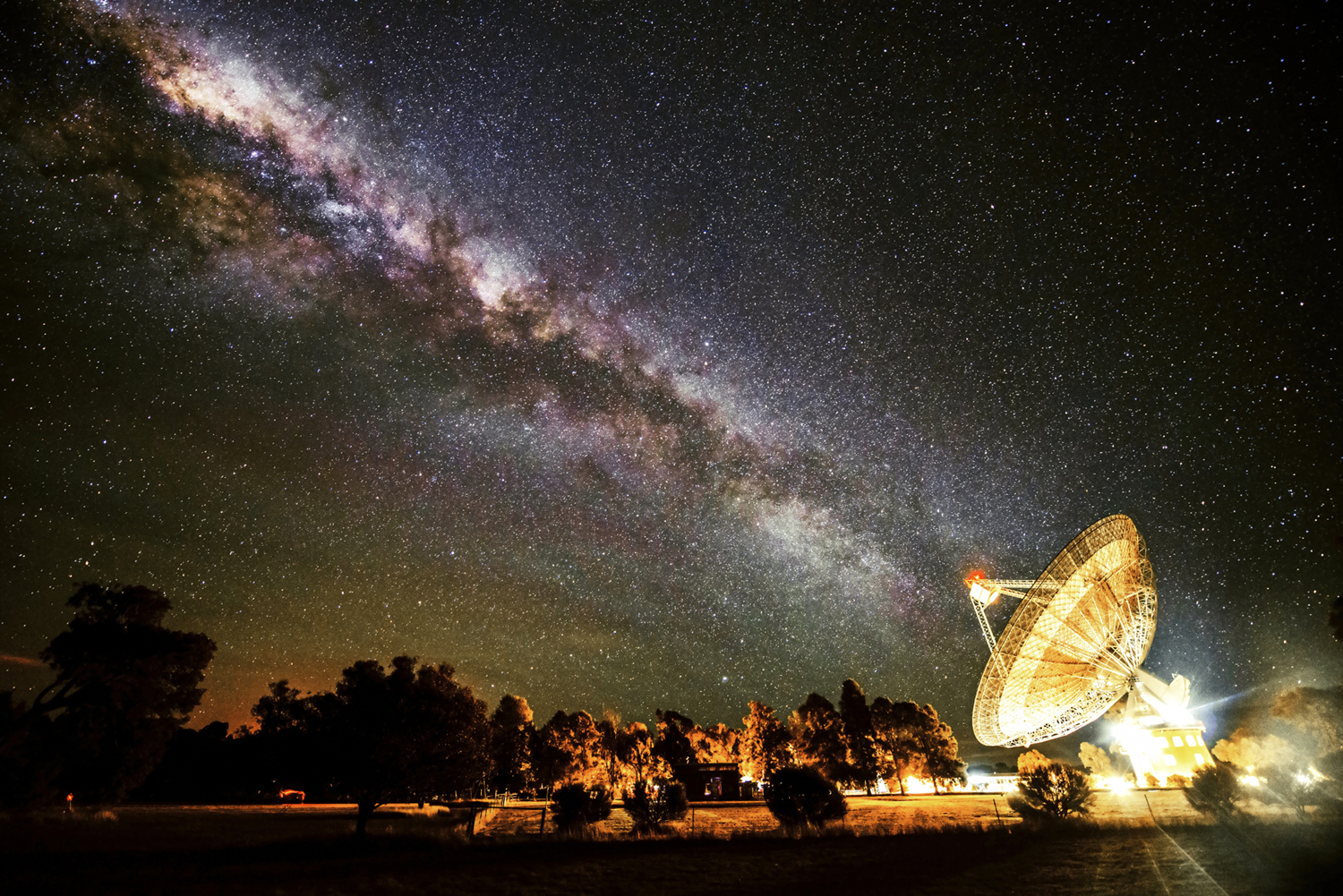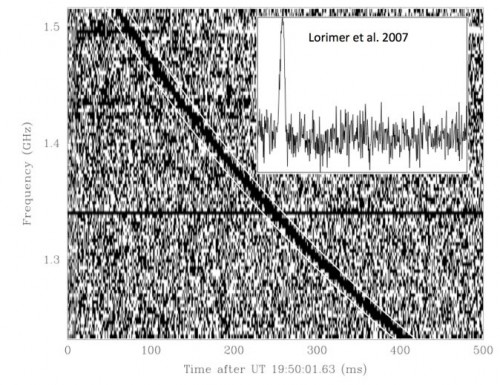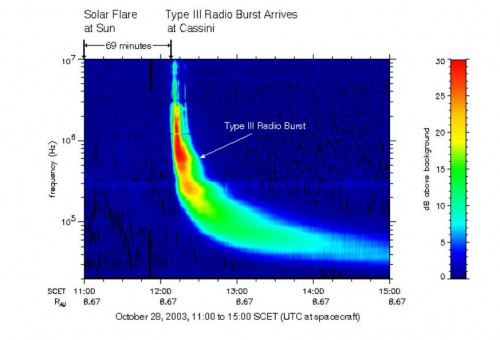
Take a set of enigmatic radio flashes that briefly appear across the sky, throw in a seeming uncertainty regarding their distance, and you have a first-rate astrophysical mystery at your hands. And, if the nature of this baffling phenomenon, better known as “fast radio bursts,” wasn’t enigmatic enough already, a new study comes to make it even more perplexing, by providing evidence for the existence of a possible mathematical pattern in the time delay of arrival between the various frequencies of these cosmic signals.
As described in an earlier AmericaSpace article, fast radio bursts, or “FRBs” for short, are very brief radio pulses which have been observed at various locations in the sky above and below the plain of the Milky Way galaxy. Even though they last only a few milliseconds, these enigmatic radio bursts nevertheless have an estimated energy output of up to several millions to billions of Suns during a single second, making them some the most energetic cosmic radio sources ever to be discovered. The first FRB ever to be detected, better known as the “Lorimer burst,” was discovered quite by chance in 2007, following an extensive analysis of archival data that had been previously gathered with the 64-m Parkes radio telescope in Australia. Subsequent searches with the iconic radio telescope in the years that followed allowed scientists to uncover nine more such transient cosmic radio signals (one of which was detected almost in real-time) that seemed to be of extragalactic origin as well, helping to establish FRBs as a true astrophysical phenomenon, rather than the result of data artifacts or instrument glitches. Finally, a team of researchers scanning the northern skies with the 305-m Arecibo radio telescope in Puerto Rico discovered a 3-milliseconds burst in the direction of the constellation Auriga, showing that FRBs weren’t a phenomenon limited to a specific area of the sky, but was widespread throughout the entire celestial sphere.

At this point, the exact nature of the mysterious fast radio bursts is anybody’s guess, with no shortage of exotic hypotheses being proposed within the scientific community in order to account for the seemingly extragalactic origin of these fleeting cosmic radio flashes, including superconducting cosmic strings and hypothetical exploding white holes, as well as more mundane ones like the merger of rapidly rotating pulsars in distant galaxies. The evidence in support of an extragalactic origin for FRBs come from the latter’s observed dispersion measure. More specifically, when radio waves are emitted by a cosmic radio source along our line of sight, they are dispersed by the ionised gas of the interstellar and intergalactic medium, which causes their lower frequencies to arrive on Earth later than their higher ones. This time delay in the arrival of the radio wavelengths is dependent on the electron density of the intervening ionised gas. The longer the delay, the greater the density of the intervening medium and the longer the distance the radio waves have to travel to reach Earth. The wavelength dispersion of most of the FRBs detected so far indicate they must lie at cosmic distances, approximately between 1.6 and 7.7 billion light-years away.
Nevertheless, not everyone is convinced that FRBs could indeed be originating from beyond the Milky Way. A study published in early 2014 argued that fast radio bursts are in reality lying closer to home, resulting from stellar eruptions in the coronae of stars within the Milky Way. These eruptions have properties which mimic the radio dispersion effects of the intergalactic medium, making FRBs appear more distant than they really are. Now, an intriguing new study by a research team led by Michel Hippke from the Institute for Data Analysis in Germany, which was published online late last month on the open-access arXiv archive, similarly suggests that fast radio bursts might be constrained within our galaxy, while also reporting on a possible mathematical pattern in the time delay in the arrival of the various radio wavelengths for each one of the FRBs that have been discovered to date. More specifically, Hippke’s team observed a surprising linear spacing in the dispersion measure of all known FRBs, which was found to be the exact integer multiple of the number 187.5, which in turn was exactly half the value of the dispersion measure of the Lorimer burst (which has the lowest such measure among all eleven known FRBs). In other words, half of the FRBs discovered to date appear to have evenly spaced distances from Earth. “We have noted a potential discrete spacing in the dispersion measures of FRBs,” write the researchers in their study. “FRB010724, the first found, has the lowest DM of 375 pc/cm3. Taking half this value, DMtry =187.5 pc/cm3 gives near-perfect estimates for the other FRBs when multiplying DMtry with integer numbers. This linear trend is virtually unchanged when plotting a line through the highest and lowest DM data point: Dmtry=184.3.”
![The dispersion measure of the eleven fast radio bursts that have been discovered to date, exhibits a surprising linear spacing which is the exact integer multiple of the number 187.5. Image Credit: Hippke et al, arXiv:1503.05245 [astro-ph.HE] (2015)](https://www.americaspace.com/wp-content/uploads/2015/04/222-500x468.jpg)
To many people’s minds, such claims can only mean that an extraterrestrial intelligence must be at play. Yet the history of SETI, which is the scientific search of extraterrestrial intelligence, is riddled with instances of false alarms, when scientists had the erroneous impression that what they were observing were evidence for the existence of alien civilisations. The discovery of pulsars and quasars in the 1960s (which are two different naturally occuring astrophysical phenomena) are some of the most famous such incidents. With that in mind, even though Hippke’s team concluded that the probability of the observed mathematical pattern in the dispersion measure of FRBs being just a coincidence was less than 5 in 10,000, at the same time they underscored the need for caution in the interpretation of their findings, as well as the need for observations of more FRBs that could help to shed some light on the overall mystery. “We conclude that the [mathematical] trend is not likely to be the result of numerical fluctuations, but we remain cautious due to the problem of forming an unmotivated hypothesis after looking at the data. Examples of finding false clustering in sky map data in a slightly di fferent context, such as cosmic ray arrival directions, are abundant; but these do get sorted out by further data.”
“It’s always tempting to invoke dramatic explanations for novel phenomena — after all, that makes them both more interesting and more important,” Seth Shostak comments on the issue, a world-renowned astronomer at the SETI Institute, in Mountain View, Calif. “But history suggests that caution is a good idea, and more likely to be justified in the end. In the case of the FRBs, one possible explanation — still not ruled out — is positively prosaic: They could be some type of man-made interference that only seems to be coming from deep space.”

Still, the possibility exists that in the end the mathematical pattern that has been observed by Hippke’s team in the dispersion measure of FRBs will be found to be the result of observational bias or, as Shostak suggests, the result of man-made radio interference. Indeed, even though the dispersion measure of fast radio bursts strongly suggests a cosmic origin, these mysterious cosmic flashes nevertheless share some similar properties with the equally mystifying “Peryton flashes,” which are short radio flashes that are though to be caused by things like mobile communication antennas, airborne ballons and orbiting satellites. “As perytons are thought to be produced on Earth, this would imply that FRBs are also Earthly noise,” write Hippke’s team. “Indeed, why would both perytons and FRBs show arrival times with a strong correlation to Earth’s integer second? This hints at some man-made device, such as mobile phone base stations … In the end we only claim interesting features which further data will verify or refute,” conclude the researchers.
Fast radio bursts are the latest in the long line of nagging astrophysical mysteries which demand an explanation. Whatever the answer for this enigmatic cosmic phenomenon might be, it promises to provide ground-breaking insights about our Universe—either about the physics of our atmosphere, or of the interstellar medium itself, or, if the observations eventually stand the test of time, of who else might actually be out there in the cosmic dark.
Want to keep up-to-date with all things space? Be sure to “Like” AmericaSpace on Facebook and follow us on Twitter: @AmericaSpace




Very thought provoking article, AmericaSpace, comprehensive and well researched. Keep up the good work.
Thank you very much for your kind comments Paul, I appreciate it!
Kind regards,
Leonidas Papadopoulos
National Geographic recently did a piece on FRBs that included another take on Hippke’s paper – that the data set is too small to come to any real conclusions. Michael Kramer of the Max Plank institute says there have been 5 more recorded that don’t fit the Hippke’s model. Also interesting – all but one of the FRBs were recorded from only one ground station in Australia, which suggests another possibility that it’s an artifact of the equipment configuration there or actually something of terrestrial origin at that location.
This is a really fascinating topic, and I’ll second Paul’s compliments. Great work Leonidas.
Thank you Tim!
I have also read Nat-Geo’s coverage and that’s why I personally remain skeptical (yet, cautiously optimistic at the same time) about the results of Hippke’s team, which are really fascinating nevertheless! Whatever the case, I believe that the true nature of FRBs, when finally revealed, will prove to be quite something…
Kind regards,
Leonidas